What Is Content Optimization?
Content optimisation refers to the creation and optimization of online content (e.g., articles, blog posts, web pages) to improve its visibility and rankings in search engine results.
It involves using relevant keywords, providing valuable information, and adhering to SEO best practices to attract organic traffic from search engines.
This complete guide will teach you all about content optimization, making it easier for you to improve your online content and connect better with your audience.
Why Is Content Optimization Important?
SEO content optimization is crucial for several reasons:
It helps websites rank higher in search engine results, increasing visibility and organic traffic.
Well-optimized SEO content provides value to users, leading to better user engagement and satisfaction.
SEO-optimized content allows websites to target specific keywords and topics, improving their relevance to search queries.
Higher search engine rankings can lead to more opportunities for backlinks and increased authority within the industry.
Creating Content Vs Content Optimization
Creating content is the process of crafting original and valuable material that resonates with your target audience. This content could take various forms, such as articles, videos, infographics, or podcasts.
The primary goal is to capture your audience's attention, provide them with meaningful information, and establish your brand's credibility.
Content optimization, on the other hand, is about taking the content you've created and refining it to ensure it performs well in search engine results and provides an excellent user experience.
This involves strategically incorporating relevant keywords, organizing content with headings and subheadings, optimizing images for faster loading, and ensuring mobile responsiveness.
The relationship between creating content and content optimization is symbiotic. When you create high-quality content, you set the stage for effective optimization.
By considering optimization elements during the content creation process, like using relevant keywords and maintaining a clear structure, you create a strong foundation for search engine visibility and user engagement.
As you analyze the performance of your content over time, you might identify opportunities for optimization to further enhance its reach and impact.
By regularly refining your existing content based on performance metrics and evolving search trends, you ensure that your digital presence remains relevant and continues to attract organic traffic.
How To Optimize Content For SEO
Crafting SEO content is all about providing what searchers want and making it engaging.
The process involves several steps to ensure that the content not only attracts traffic but also ranks well and meets the needs of the audience.
Let's take a look at each step in more detail:
Choose A Proven Topic
To begin with, select a topic that has traffic potential, business potential, and the potential to rank well in search engines.
This is usually determined through keyword research which is the foundation of SEO-optimized content.
Here is a complete guide on Keyword Research that you can get your hands on to understand the complete process.
Analyze Search Intent
Understanding search intent is crucial because content that aligns with what searchers are looking for has a better chance of ranking higher.
Analyzing the top-ranking pages for the target keyword helps to infer the searcher's intent.
Check the three Cs:
Content type: Examine whether these pages are in the form of blog posts, product pages, landing pages, or any other specific format.
Content format: Evaluate whether the content takes the shape of tutorials, listicles, how-to guides, or any other distinctive format.
Content angle: Pay attention to whether a predominant selling point emerges, such as highlighting low prices or emphasizing ease of use.
For instance, if the top search results for the keyword 'local SEO tips' predominantly feature comprehensive guides with step-by-step instructions, this indicates the prevailing content angle.
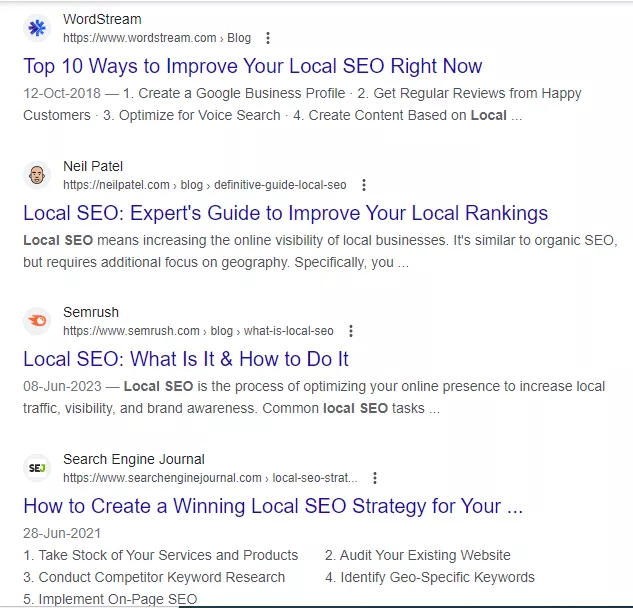
Fully Cover The Topic
Create comprehensive content that addresses all aspects of the topic. While analyzing search intent offers a preliminary understanding, it might not unveil every facet.
This poses a challenge since an ideal search result should encompass all the information searchers are seeking.
To pinpoint vital sub-topics and key elements to incorporate, you can utilize these approaches:
Identify Patterns Among Top-Ranking Pages: Pay attention to the headings on the top-ranked pages. These headings can show you common topics and important information people are looking for.
Recognize Shared Keyword Rankings Among Leading Pages: Watch for words that appear a lot on high-ranking pages. These words can show what topics people care about. If many sources talk about these topics, it means they are important.
A tool like Ahrefs can facilitate this process:
Paste your webpage URL for a chosen keyword in "Ahrefs’ Site Explorer".
Go to the "Content Gap" tool.
Input the top three to five competitor URLs.
Click "Show keywords" for insights.
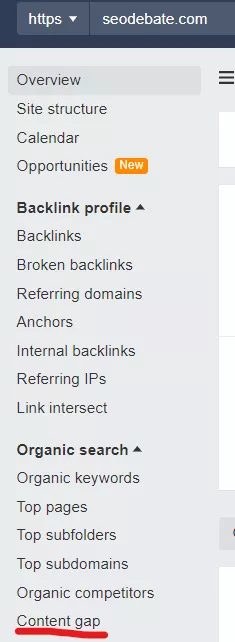
For example, let's use the keyword "digital marketing strategies." By employing Ahrefs' Content Gap function with select top-ranking pages, you can unveil numerous keywords linked to subtopics.
This analysis demonstrates that users aren't solely seeking insights into various digital marketing strategies but are also interested in various other related topics.
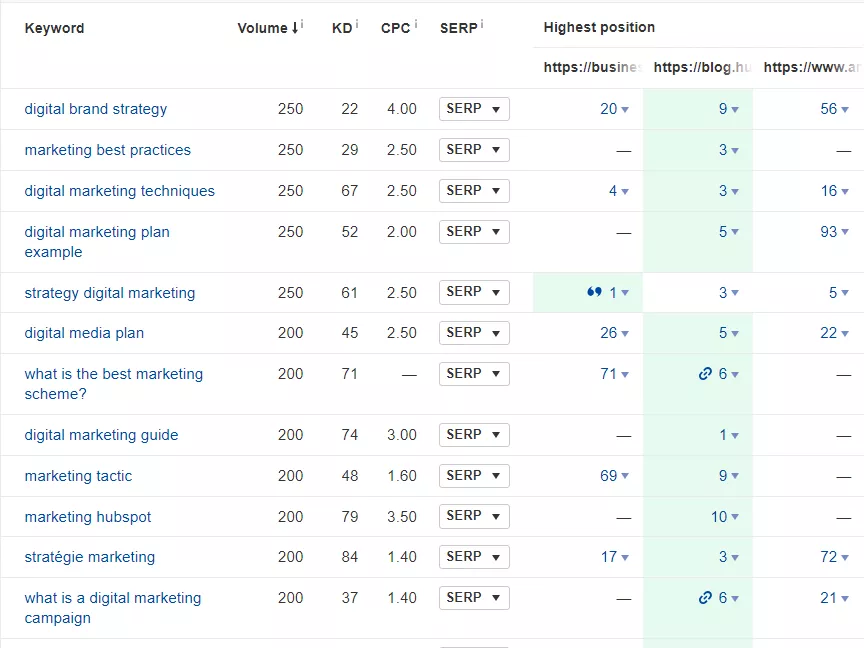
Integrate Keywords
While adapting content to align with the preferred format identified during competitor research, it's crucial to integrate the selected keywords. It involves incorporating keywords in various elements such as:
Content Body
It also highlights the importance of naturally including the main and related keywords throughout the content, while avoiding "keyword stuffing," which negatively impacts user experience and can lead to Google penalties.
Internal And External Links
Internal linking between pages on a website is often overlooked but important. It helps search engine crawlers understand site content and how pages connect.
Links also aid visitors by enabling easier navigation. When optimizing any page, it is good to mention related pages within the text and link to them.
This shows relationships between topics. It spreads authority across more site pages too.
In addition, linking out to external sites can provide value for readers seeking more depth. Choose reputable resources that boost the overall user experience.
Make It Unique & Engaging
Don't just copy other people's work. Come up with something new that is actually helpful to readers. Do your own research through surveys or studies, or share a new perspective on an existing topic.
This type of original content tends to get shared more often, which can improve your search engine rankings.
Your content should be easy to read and keep people's interest. Use simple wording instead of complicated language. Break up long blocks of text with pictures, charts, or videos. Use words your readers are familiar with.
Also, be sure you spell everything correctly and use proper grammar. This makes your site look more professional.
Effectively Managing Keyword Density
Choosing the right keywords and using their correct amount is important in SEO.
You want to include your main keyword in different places like the title, web address, and content. But you don't want to overload the content with the keyword or it looks spammy.
Using a keyword too much can frustrate readers and Google may penalize your site.
It's also about more than just one keyword. Each article you write should have a purpose - like educating, entertaining, or persuading readers.
When writing content, pick keywords that align with what you want that content to achieve. This helps the content stay interesting and useful for readers. It also follows modern SEO standards.
Stay Mindful Of Keyword Cannibalization
Keyword cannibalization is when you optimize multiple pages on your site for the same keyword phrase.
Unfortunately, this makes those pages compete against each other in search results. That can hurt your rankings and lower your website traffic.
To prevent this problem, you should target a different primary keyword for each page.
Make sure every page focuses on a unique main keyword. This protects your search rankings and overall website traffic.
Get in-depth insights on Keyword cannibalisation by reading this guide.
A straightforward way to determine whether you're currently ranking for a specific keyword involves a Google search.
Follow this formula: Type "Site:" followed by your website name, then include the targeted "keyword" within quotation marks. For an even more precise match, you can integrate the "^" symbol.

Focus On Evergreen Content
Finally, aim to create evergreen content that remains relevant over time. Some topics need regular updates to stay current and keep getting traffic.
Outdated content typically drops in rankings. So it's important to check older content and refresh it as needed. This helps keep it attracting visitors over time.
How To Optimize Content For Conversions
Not all content needs to focus on SEO. Some articles should aim to guide readers down a conversion funnel.
Think about what action you want people to take after reading each piece of content.
Here are some important things to remember when writing SEO content meant to convert readers:
Target Commercial Keywords and Topics
Picking the right topic is key for content that generates sales.
Prioritize keywords that show user intent to buy or research a solution. It's even better if those keywords relate to your products or services.
For example, a digital marketing company could browse related questions on Quora to find blog ideas.
This helps create content about topics that matter to potential customers. That makes readers more likely to convert.
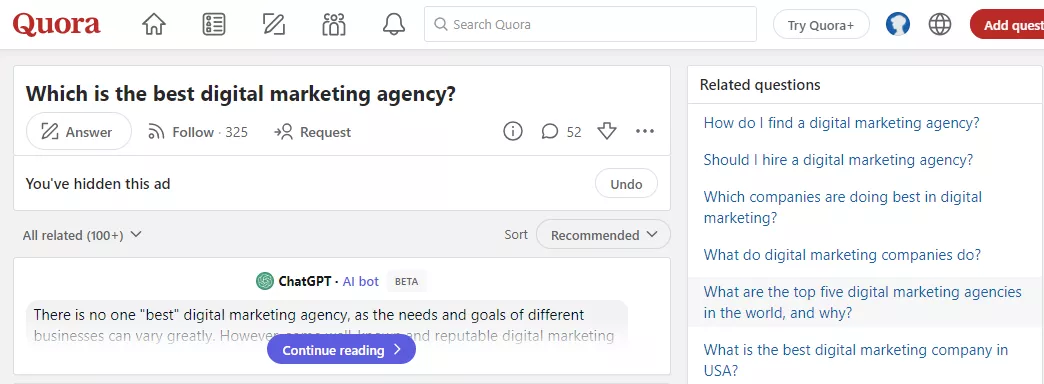
Understanding Your Target Audience
It's important to tailor your content to the right audience.
For example, say you're a B2B advertising agency. Your main readers are decision-makers like marketing managers at other companies.
To reach them effectively, use language and terms they understand. This shows you know their industry and makes you seem credible.
Also, understand the types of challenges these marketing managers face daily - like limited budgets, increasing competition, changing consumer behaviour, etc.
Creating content that relates to their specific struggles makes it more resonant and impactful for them. It shows you get what they're dealing with.
Employ Persuasive Techniques
Employing persuasive strategies can significantly enhance the appeal of your copy. Some effective techniques include:
Showcasing Social Proof: Highlight instances where real individuals endorse your product, showcasing its value and authenticity.
Friendly Tone: Adopting a friendly and relatable tone helps build a positive connection with your readers.
Utilizing Case Studies: Presenting real-world examples and case studies that demonstrate the effectiveness of your product can boost credibility and trust.
Combining these tactics within a single piece of content amplifies their impact.
Crafting An Effective Call to Action
Calls-to-action (CTAs) are important for getting readers to take actions like signing up or clicking a link. Here are some tips:
Place CTAs strategically to align with your goals, like moving readers through a sales funnel or building engagement.
Understand where readers are in their journey. New readers may need more information first before a direct sales pitch.
Use formatting like bullets, headings, charts, etc. to make content more readable and appealing.
Show how your product solves reader problems instead of just listing features. Use real examples that highlight the product's value.
Write conversationally in a friendly, helpful tone instead of sounding pushy or only focused on making a sale.
How To Optimize Content For Social Shares
Here are key strategies to amplify exposure:
Incorporate Expert Quotes
Adding one-of-a-kind quotes from experts can help more people see your content.
If you mention an expert in your post, they will probably share it when it gets posted.
This spreads your content further. It makes your points seem more believable too, without having to do lots of research yourself.
This works even if the experts don't have huge followings. On sites like LinkedIn, tagging the experts can make your post show up for more people.
Selecting The Right Experts
Choose experts who are respected and know the topic well.
Good options could be famous people in the field, industry leaders, professionals, or people with large social media followings.
Getting these credible experts to contribute to your content can help it spread much further. Their backing also makes more people in your target audience pay attention and relate to what you write.
Selecting the right experts entails:
Relevance: Experts should have direct relevance to the topic of your content. Their expertise should align with the subject you're discussing to ensure their insights add value and credibility.
Credibility: Choose experts who are widely recognized and respected in the industry. Their credibility will reflect positively on your content and encourage social sharing.
Engagement Potential: Experts with an active and engaged online presence are more likely to share your content with their own followers, thus increasing its exposure.
Audience Alignment: Consider whether the expert's audience aligns with your target audience. This can help you tap into a new and relevant audience segment.
Diversity Of Perspectives: Including a range of experts with diverse viewpoints can make your content more comprehensive and appealing to a wider audience.
Ease of Collaboration: Experts who are approachable and willing to collaborate can provide valuable insights and potentially promote your content to their network.
Recommended Reading: Influencers Marketing
Ensure Visible Social Share Buttons
Since many readers might not finish your entire post, it's really important to always have social share buttons easily visible.
The goal is to encourage readers to share your content on their social media profiles, thereby increasing its visibility and reach across various social platforms.
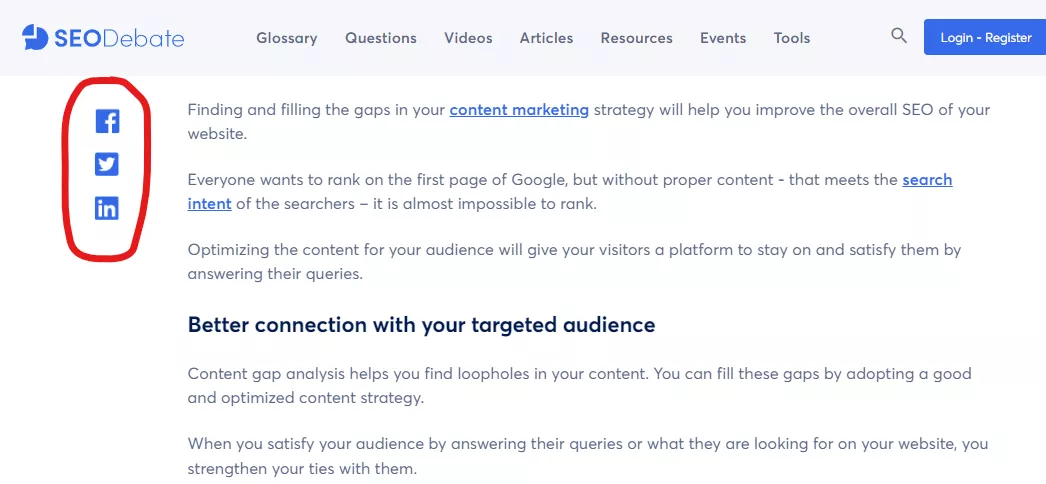
To implement visible social share buttons effectively:
Placement: Position the share buttons prominently on your content page. Implement "sticky" or fixed share buttons that remain visible as the reader scrolls. This ensures the buttons are always accessible, regardless of where the reader is on the page.
Size and Design: Make the buttons large enough to be easily clickable, but not so large that they overwhelm the content. Use attractive icons that align with the design of your website.
Colour and Contrast: Choose colours that stand out against your content background. The buttons should be easily distinguishable from the rest of the page.
Mobile Optimization: Ensure that the social share buttons are mobile-friendly and responsive. Mobile users should have a seamless experience when sharing your content.
Platform Selection: Include share buttons for the most relevant social media platforms. Concentrate on the platforms where your intended audience is most engaged.
Here we have a complete guide on Social Media Sharing. Read it to understand the topic in detail.
How To Optimize Content For Backlinks
At the core of effective SEO lies the strategy of acquiring backlinks.
Enhancing the linkability of your content can be achieved through various tactics:
Challenging Conventional Wisdom
One way to go about this is by sharing perspectives that question widely held beliefs. This can help you grab people's attention and potentially get more links back to your content.
But remember, don't just stir up controversy for the sake of attention; the long-term impact is what really matters.
Offering Originality
New ideas or concepts that challenge the usual ways of thinking can spark curiosity and make people want to share.
When your unique viewpoint connects with readers, it could result in getting many important links back to your content.
Creating your own research is a great example of content that can really get noticed.
Establish Authority
Aim for creating content that holds authority. While it's particularly important in certain fields to involve well-known experts, this idea works across the board.
Content supported by knowledgeable perspectives or contributions holds credibility and is more likely to get valuable links from others.
Following & Leveraging Trends
Monitoring the latest trends in your field and producing valuable content on those subjects is a way to remain relevant.
However, authenticity is crucial; just following trends without adding valuable insights can have negative results.
Validating Opinions
Match your content with what your audience believes and cares about. Create content that inspires or encourages action to form emotional bonds.
When your content aligns with their views, they are more likely to share it. Stories that people can relate to can also push them to share with their friends and connections.
How To Optimize Content Quality
Now that we've covered these important principles for improving your content's ranking, let's turn our attention to another crucial aspect: enhancing the overall quality of your content.
Crafting captivating and engaging content can be a challenge, even for skilled writers. However, we have uncovered some straightforward tips that seamlessly improve writing quality:
Personalization
The trend of infusing content with a human touch has gained momentum. Before you begin writing, thoroughly understand your target audience.
Customize your content to connect with what they care about and talk about things that are important to them, using words they can understand.
Conversational Style
Pick a writing style that sounds like a regular conversation rather than complex academic language. Use shorter words and sentences to make your content easier to read and understand.
This way, readers can get information more effortlessly. Create content using words and phrases that your audience already knows, making it easy for them to engage without any effort.
Consistent Tone
Establishing a uniform tone of voice across your content pieces enhances your brand's image and leaves a lasting impression.
Keeping the same tone throughout your content strengthens your brand image and builds a stronger bond with readers.
Understanding the importance of how you speak in your content is really crucial because it shapes how your content affects people and connects with the people you're aiming for.
By using these methods, you can make your content better and create a more captivating and meaningful experience for your readers.
How To Optimize Content For Other Formats
Optimizing each type of content on your website is crucial for SEO success. Besides text, visual content also matters.
So here are a few ways by which you can optimize the other formats of content.
Optimizing Video Content
YouTube is an excellent platform to showcase your brand and reach a wide audience. To optimize video content, here are some helpful tips:
Relevant & Interesting Titles
Similar to how regular Google searches work, YouTube's search results are affected by the words people search for.
Create titles that have your main keyword and also give a clear idea of what the video is about to grab the viewer's attention.
Maximize Video Description
Write a compelling description that offers a preview of the video's content. Include a link to your website for further information, in case viewers want to learn more.
Optimize Video File Name
The video's file name is included in the embedding code when it's shared on other websites.
Use a descriptive and memorable file name that includes your targeted keyword. This is similar to how you would optimize an image with a relevant keyword.
Optimizing Images
After dedicating efforts to strategizing, creating, publishing, and optimizing your content, it's essential not to overlook the optimization of your images for maximum impact.
Image optimization not only improves engagement but also makes content more accessible to users with impaired sight.
They serve as powerful aids that enhance the overall reader experience. Here is how you can optimize your website images for better performance:
Alt Tags
Alt tags offer a description of an image in case it can't be shown or loads slowly on a webpage. These tags should have your chosen keyword and accurately explain the image.
Image Tags
Image tags are descriptions that appear when a user hovers over an image. Similar to alt tags, these descriptions should effectively convey what's happening in the visual content.
Quality
Choose high-quality images that are clear and visually attractive.
Placement
Integrate images naturally throughout your content, ensuring they align with the surrounding text.
File Name
A descriptive and memorable file name enhances visibility. When uploading images to your website, rename them with relevant keywords or phrases.
Optimizing News Content
Optimizing news content is also crucial due to the competitive online news landscape.
This optimization is aimed at achieving better search engine rankings and engaging the ongoing interest of readers, which ultimately benefits the business.
To achieve effective news content optimization, there are several key considerations:
Google News Inclusion: For visibility in Google News results, businesses need to directly submit their news-related sections to Google News. Google's news team evaluates the content, and if it meets their criteria, it appears in news search results. It's important to follow Google News' specific requirements for submission.
Keywords: Just like any other content, news articles should incorporate relevant keywords. However, striking a balance is key.
Headlines: Captivating headlines are vital to capturing readers' attention. Similar to regular search results, well-optimized headlines are essential for high rankings in news search results. This requires complete metadata, including the targeted keywords, for the news content.
Common Optimization Mistakes
Now that we have explored all the main approaches to optimising content, let's discuss the typical mistakes you frequently come across in content optimization.
Neglecting User Intent
One of the common mistakes is focusing solely on optimizing content for a specific keyword without considering the underlying intent behind that keyword.
For instance, if the search query is informational, like "how to do website SEO," it's crucial to create content that addresses the user's need for a how-to guide rather than simply promoting an SEO tool.
Aligning content with search intent enhances the user's experience and increases the likelihood of engagement.
Ignoring Reader Experience
Failing to address the actual needs and queries of your target audience can hinder your content's effectiveness.
Some website owners prioritize improving their content's SEO but overlook the reader's experience.
This approach can lead to high traffic numbers but also result in a high bounce rate and minimal conversions.
To combat this, it's important to create content that not only ranks well in search engines but also provides valuable and engaging information for the readers.
Prioritize providing valuable answers and solutions to user queries to enhance user satisfaction and engagement.
Underestimating The Power of Internal Links
Internal linking is a strategy that often doesn't get enough attention. These links don't just direct users to related content, but they also spread authority and relevance across various pages.
This approach optimizes multiple pages at once, but it's something that people often forget about.
Neglecting internal linking within your content can hinder user navigation and hinder the flow of link equity throughout your website.
So, incorporate relevant internal links to guide users to related content and improve the overall site structure.
Not improving the content
SEO Content optimization goes beyond just using keywords. To rank effectively, it's crucial to deeply explore a topic, offering thorough and valuable insights.
Covering a subject comprehensively positions your content as a valuable resource, boosting its likelihood of ranking higher and engaging users.
Over time, content can become outdated or irrelevant. Neglecting to update or remove such content can clutter your website and mislead users.
Consistently reviewing and eliminating outdated content guarantees that your site stays up-to-date and trustworthy.
Neglecting Analytics
Not regularly analyzing and evaluating how your content is doing can stop you from making smart optimization choices.
Utilize analytics tools to monitor user behaviour, engagement metrics, and conversion rates to refine your content strategy.
Crossing the Line with Keyword Stuffing
Excessive keyword optimization or keyword stuffing is a damaging approach.
Putting too many keywords in your content not only makes it bad for users but also gets you in trouble with search engines like Google.
Finding the right balance between optimization and readability is essential for long-term SEO success.
Avoiding these common content optimization mistakes will contribute to a more effective and impactful content strategy, helping you achieve better search rankings, increased traffic, and enhanced user engagement.
Takeaway
SEO Content optimization involves improving readability, incorporating relevant keywords, and structuring content for search engines.
It aims to align content with user intent, improve its search engine rankings, attract organic traffic, and foster a positive user experience.
By aligning content with user preferences and search engine algorithms, content optimization aims to drive higher organic traffic, boost engagement, and provide value to both readers and search engines.


